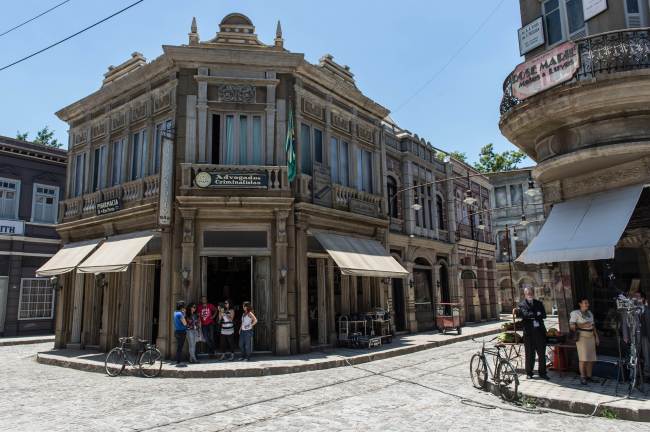 |
This open-air set reproduces Rio de Janeiro’s downtown in the 1940s for TV Globo’s soap opera “Joia Rara” at PROJAC, the production site of TV Globo, in Jacarepagua, Rio de Janerio, Brazil, on Nov. 19. (AFP-Yonhap News) |
RIO DE JANEIRO (AFP) ― In a Rio suburb, wealthy and beautiful heiresses, orphans and assassins lunch together in a mini-city where Globo television creates the soap operas that captivate more than 50 million Brazilians.
Mind-boggling, super-realistic cardboard sets are spread across 165 hectares of unused farmland surrounded by hills filled with tropical vegetation to form the ultra-modern television production center, Latin America’s largest.
Located in the Jacarepagua neighborhood, the mini-city is self-sufficient, served by a gas power plant. Around 7,000 people work to feed Brazil’s gigantic “telenovela” dream machine, traveling aboard 300 electric cars.
Once inside, a cobblestone street dating from the 1940s is dotted with storefronts that bear French names and where a group of actors is filming an episode of “Joia Rara” (Precious Jewel), which broadcasts at 6:00 p.m.
The director yells out his instructions for a scene in which a worker riles up the crowd as he seeks support for his run for a congressional seat.
He is suddenly interrupted by a woman, holding a girl by the hand, who accuses him of walking out on her when she was pregnant.
A few steps away lies Itapire, a small Amazonian city with wooden stilt houses surrounded with water, in a scene from “Beyond the Horizon,” which broadcasts at 7:00 p.m.
“The Rio of the 1940s and Itapire are just two of 22 mock-up cities currently set up within the enclosure,” said Renata Puppim, spokeswoman for this temple of TV production known as the Jacarepagua Project or simply “Projac.”
A little further, a small church has three facades, depending on the shoot’s needs of the day: colonial, gothic or contemporary.
These make-believe cities are built in three months by legions of workers and craftsmen who recycle the materials from one soap opera to the next.
“We are Brazil’s number one consumer of nails, and among the first of lumber and paint. Each soap opera needs about 60 highly sophisticated sets,” said Puppim.
Objects used during filming are carefully preserved, including 180,000 costumes ordered by time period and hanging in a huge cloak room.
As soaps go, so goes fashion
TV series, which last six to eight months and are broadcast six days of the week, bring much fame to the actors, who are better paid than their colleagues in film.
They often head up fashion trends and even characters’ expressions are mimicked by fans.
“Joia Rara” lead actor Bruno Gagliasso, 31, was hired by Globo in 2001. He noted that the television network covers 99 percent of the Brazilian territory home to 200 million people.
“But a film, when it is successful, is only seen by a million people,” Gagliasso said.
Launched in 1995, Projac features 65 hectares of developed land and another 100 reserved for reforestation efforts.
The project groups all soap opera production activities, from filming to sets, costumes and special effects, and from recording studios ― including four that are 1,000 square meters ― to editing and mixing suites.
A world record
“More than 2,500 hours of programming and series are produced each year, a world record,” said Raphael Correa Netto, Globo’s director of international sales.
“In 2012, Globo marketed 59 products equivalent to 25,000 hours of content in 33 different languages for 92 countries. In the first semester of this year, 42 titles were marketed for 123 countries.”
The star series of 9 p.m., “Avenida Brasil,” reflects the 40 million Brazilians who have recently joined the middle class.
A big success last year, “it saw its broadcast rights bought by 124 countries during the past 10 months and was dubbed in 17 languages, a record in terms of rights in the history of Globo,” Netto said.
The key to soap opera success for Globo has been to lock in a good story on universal themes that gives hope to all ethnic and social groups. The story varies depending on the public’s expectations and current news trends.
These monster productions that last between 180 and 200 episodes require massive budgets, by Brazilian standards, of about 700,000 reais a piece ($307,200), according to Netto. But Globo defrays the costs through advertising and the marketing of an assortment of related products.








